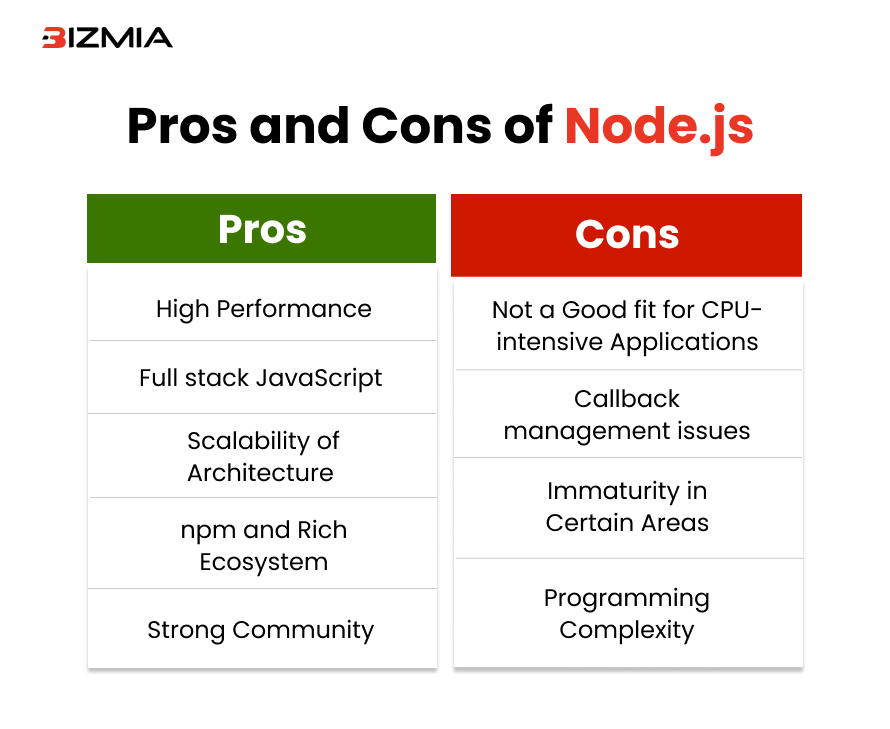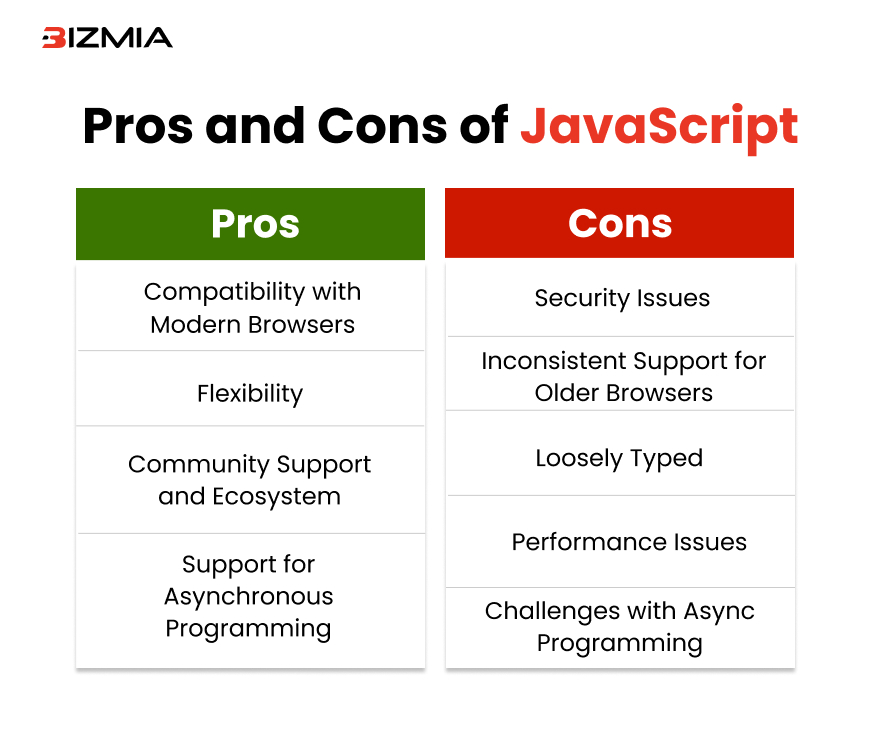When opting for the right platform for building web projects, developers often come across Node.js vs JavaScript debate. Although both terms are mistakenly used interchangeably, they are involved in different tasks during web development. JavaScript is a programming language, and Node.js is a runtime environment that enables JavaScript to run on the server side.
To select the right tool according to your project requirements, you need to understand the clear differences between Node.js and JavaScript, as well as their pros and cons. Give this blog a read before selecting any of these platforms so that you can make the right decision.
What is Node.js?
Built on Google Chrome’s V8 JavaScript engine, Node.js is a server-side runtime environment. It was developed in 2009 to enable JavaScript to run on a server. Due to this innovation, doors for JavaScript web development are opened. So that developers can write both backend and front-end code.
Moreover, various built-in modules are offered by Node.js to handle multiple server-side operations like networking, HTTP requests, and file system access. An event-driven non-blocking architecture is used by Node.js, making it an efficient platform for managing concurrent requests. Also, this architecture helps stream platforms, real-time data services, and REST APIs.
What is JavaScript?
It’s an interpreted scripting language of a high level. JavaScript was designed to add interactivity to static HTML web pages, then with the passing of time, it evolved into one of the most widely used programming languages with the best JavaScript frameworks.
Most of the interactive functionality you see on modern websites is backed by JavaScript, from single-page web applications to interactive forms and dropdown menus. Also, it is supported by all major browsers.
What’s the Core Difference Between Node.js Vs JavaScript?
Although JavaScript and Node.js are connected, there are major differences in their environments and roles. Being a programming language JavaScript was designed to run in the browser. On the other hand, Node.js is an environment that enables JavaScript to run on a server. Let’s look at the given table to see a clear difference between Node.js and JavaScript:
| Feature | Node.js | JavaScript |
| Type | Runtime environment | Programming language |
| Execution | Server | Web browser |
| Major usage | Backend development | Frontend development |
| File access | Full access | No direct access |
| Threading | Non-blocking I\O | Event driven |
| Single-threaded | Modules\Libraries | Built-in backend modules |
Node.js for Backend: Is it a Reliable Choice?
For backend development, Node.js is a fantastic option, especially for applications requiring real-time capabilities, performance, and scalability. It can also handle numerous simultaneous connections without getting slowed down. Another key benefit of using Node.js for the backend is its ability to leverage JavaScript across both client and server.
It also facilitates the collaboration between development teams and makes project completion faster. A wide range of backend functionalities supported by Node.js including API development, middleware integration, and routing. Moreover, Node.js is used for designing IoT dashboards, streaming services, real-time chat applications, and RESTful APIs. Support from the active developers’ community and its modular design makes it a forward-looking and reliable platform.
Do you need help using Node.js for backend development?
Pros and Cons of Node.js
Let’s see some pros and cons of Node.js that you may have while using it for your web projects:
Pros of Node.js
- High Performance: Built on a V8 engine, Node.js compiles JavaScript to native machine code for better execution.
- Full stack JavaScript: Developers can write both backend and frontend code in JavaScript with the help of Node.js, improving workflow efficiency and reducing complexity.
- Scalability of Architecture: With Node.js you excel in building scalable web applications, especially those using serverless models and microservices. In the case of Laravel vs Node.js, the latter is more scalable.
- npm and Rich Ecosystem: Many open-source source libraries are provided by npm registry that enhances and simplifies the development process.
- Community Support: Startups and tech giants are adopting Node.js because of its thriving community that makes it easy to find support and resources. Moreover, you can hire Node.js developers to fully leverage this technology.
Cons of Node.js
- Not a Good Fit for CPU-intensive Applications: Because Node.js runs on a single thread, that’s why it is not suitable for tasks requiring heavy computation.
- Callback management issues: Handling deeply nested call-backs with Node.js can lead to hard-to-maintain and complex code.
- Immaturity in Certain Areas: In comparison with Java, .NET, or other technologies, Node.js modules may lack long-term support and maturity.
- Programming Complexity: With Node.js, error handling and debugging in asynchronous code is difficult as compared to traditional synchronous codebases.

Pros and Cons of JavaScript
Although JavaScript is a popular coding language among developers due to multiple benefits, it has its own limitations as well:
Pros of JavaScript
- Compatibility with Modern Browsers: Natively JavaScript is supported by all browsers (including Chrome, Safari, Firefox, and Edge) avoiding any additional installations and plugins.
- Flexibility: Capabilities of frontend, backend, and mobile app development make JavaScript a highly flexible and versatile language.
- Community Support and Ecosystem: Dynamic interaction and faster prototyping are possible with the loosely typed nature of JavaScript. It’s also useful for agile development environments.
- Support for Asynchronous Programming: Asynchronous programming patterns are supported by JavaScript to improve performance.
Cons of JavaScript
- Security Issues: While running in a browser, JavaScript may get exposed to security risks like injection attacks and cross-site scripting.
- Inconsistent Support for Older Browsers: Many modern features of JavaScript are not supported by older browsers.
- Loosely Typed: JavaScript is a loosely typed scripting language and leads to more debugging challenges and runtime errors.
- Performance Issues: In the case of large data processing tasks and CPU-intensive operations JavaScript may struggle.
- Challenges with Async Programming: The asynchronous behavior of JavaScript can lead to code complexities such as code is difficult to follow called callback hell.

When to opt for JavaScript Vs Node.js
Choosing between JavaScript and Node.js solely depends on your project requirements and application architecture.
- You can use JavaScript in the browser when you plan for:
- Designing interactive user interfaces
- Manipulating CSS and HTML
- Managing user events and frontend validation
- Animating control user behavior and elements
You can use Node.js while planning for:
- Building real-time and scalable applications
- GraphQL services or developing RESTful APIs
- Designing server-side web pages
- Handling database interactions, backend business logic, and file uploads
Some Use Cases of Node.js
Some real-world use cases of Node.js include:
- Netflix: To manage millions of concurrent streams, Netflix uses Node.js for backend development.
- LinkedIn: Shifted to Node.js from Ruby on Rails and saw a performance hike and reduced server resources.
- Trello: Opted for Node.js to offer real-time updates to customers.
What Will be the Future Outlook?
In the web development ecosystem, it seems that both Node.js and JavaScript have a bright future. The reason is JavaScript continues to evolve by introducing new capabilities, cleaner syntax, and ECMAScript standards. Node.js also maintains its position as a popular and dominant technology for backend development. With the increasing popularity of edge computing, APIs, and serverless architecture, Node.js is being used in cloud-native applications and microservices, fostering a better future as well.
Conclusion
To make the right choice between Node.js and JavaScript, you should keep in mind what your project’s nature and requirements are. Node.js enables server-side development, on the other hand, JavaScript brings your front-end development to life. So, you can use JavaScript when you need to build interactive frontends and Node.js for building backend systems. However, for web developers, the winning formula is to combine both technologies in a full-stack JavaScript approach providing scalability and speed ensuring a unified development experience.
Are you confused about selecting the right tech stack?
FAQs
1. Why use Node.js for backend development?
Due to its speed, ability to handle multiple requests simultaneously, and scalability, Node.js is the perfect technology for backend web development. Moreover, it’s ideal for microservices and real-time applications.
2. Is it possible to use JavaScript without Node.js?
Yes, of course, you can use JavaScript without Node.js, as it’s an independent language and runs independently in web browsers. You only need Node.js alongside when you have to run JavaScript on the server.
3. Are there any limitations in using Node.js?
Yes, there are limitations in using Node.js as it’s not the right fit for CPU-intensive applications and is difficult to manage without proper tools and structure.












